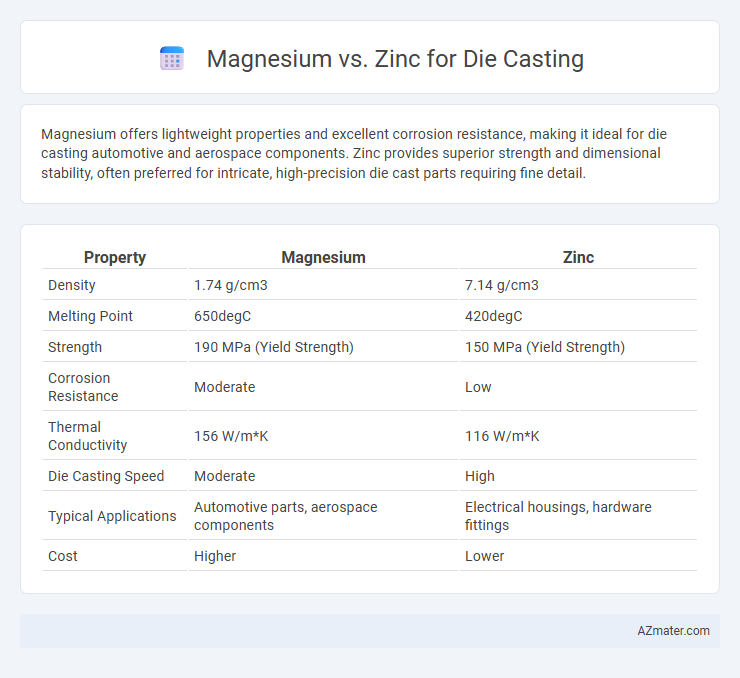Magnesium offers lightweight properties and excellent corrosion resistance, making it ideal for die casting automotive and aerospace components. Zinc provides superior strength and dimensional stability, often preferred for intricate, high-precision die cast parts requiring fine detail.
Table of Comparison
| Property | Magnesium | Zinc |
|---|---|---|
| Density | 1.74 g/cm3 | 7.14 g/cm3 |
| Melting Point | 650degC | 420degC |
| Strength | 190 MPa (Yield Strength) | 150 MPa (Yield Strength) |
| Corrosion Resistance | Moderate | Low |
| Thermal Conductivity | 156 W/m*K | 116 W/m*K |
| Die Casting Speed | Moderate | High |
| Typical Applications | Automotive parts, aerospace components | Electrical housings, hardware fittings |
| Cost | Higher | Lower |
Introduction: Magnesium vs Zinc in Die Casting
Magnesium and zinc are two of the most commonly used metals in die casting due to their distinct properties and applications. Magnesium offers a lightweight solution with excellent strength-to-weight ratio, making it ideal for automotive and aerospace parts requiring reduced weight and high performance. Zinc provides superior durability, corrosion resistance, and dimensional stability, often preferred for intricate designs and high-volume production runs.
Overview of Die Casting Materials
Magnesium and zinc are prominent die casting materials, each offering distinct advantages for manufacturing precision components. Magnesium is valued for its lightweight properties and high strength-to-weight ratio, making it ideal for automotive and aerospace applications requiring weight reduction. Zinc boasts excellent fluidity, corrosion resistance, and mechanical strength, facilitating the production of intricate shapes with fine details in industrial and consumer products.
Properties of Magnesium in Die Casting
Magnesium's lightweight nature and excellent strength-to-weight ratio make it highly desirable for die casting applications, offering superior mechanical performance and reducing overall part weight. Its high thermal conductivity enables faster cooling rates during the die casting process, improving cycle times and dimensional accuracy. Magnesium alloys also provide good corrosion resistance and machinability, making them suitable for complex automotive and aerospace components.
Properties of Zinc in Die Casting
Zinc exhibits excellent die casting properties such as low melting point (419.5degC), high fluidity, and rapid solidification, making it ideal for producing intricate shapes with fine details. Its superior dimensional stability and corrosion resistance enhance the durability and precision of die cast components used in automotive and electronics industries. Zinc alloys also offer good strength-to-weight ratio and excellent surface finish, optimizing manufacturing efficiency and final product quality.
Strength and Durability Comparison
Magnesium alloys offer a high strength-to-weight ratio, making them ideal for die casting applications requiring lightweight yet robust components, whereas zinc alloys provide superior hardness and wear resistance that contribute to enhanced durability. Zinc's higher tensile strength, typically around 300 MPa, surpasses magnesium's average tensile strength of 200-250 MPa, resulting in parts better suited for high-load environments. Magnesium excels in corrosion resistance and impact absorption, while zinc ensures longer lifespan in abrasive conditions due to its improved surface hardness.
Weight and Density Differences
Magnesium alloys used in die casting have a significantly lower density, approximately 1.74 g/cm3, compared to zinc alloys, which range around 6.6 to 7.1 g/cm3, making magnesium nearly 75% lighter by weight. This lower density translates to reduced overall component weight, enhancing fuel efficiency and ease of handling in automotive and aerospace applications. Zinc alloys, despite their higher density, offer superior strength and dimensional stability but result in heavier parts that may impact weight-sensitive designs.
Cost-Effectiveness Analysis
Magnesium offers cost-effective advantages in die casting due to its lower material density, reducing weight and shipping costs, while Zinc provides higher dimensional accuracy and better surface finish at potentially higher material expenses. The balance of cost-effectiveness depends on production volume and part complexity, with Magnesium favored for lightweight, high-volume components and Zinc suited for intricate designs requiring precision. Analyzing total costs including tooling, cycle time, and post-processing helps determine the most economical choice for specific die casting applications.
Corrosion Resistance and Longevity
Magnesium alloys in die casting offer superior corrosion resistance by forming a protective oxide layer that minimizes surface degradation, making them ideal for lightweight, durable components. Zinc alloys, although denser, provide excellent longevity through robust mechanical properties and inherent resistance to wear and corrosion in less aggressive environments. Choosing between magnesium and zinc depends on application-specific factors such as exposure conditions and weight constraints, with magnesium favored in highly corrosive environments and zinc preferred for structural durability.
Applications: When to Use Magnesium or Zinc
Magnesium is preferred in die casting for automotive and aerospace applications due to its lightweight and excellent strength-to-weight ratio, enhancing fuel efficiency and performance in structural components. Zinc is ideal for intricate, high-precision parts such as electrical housings and decorative hardware because of its superior dimensional stability and excellent corrosion resistance. Choose magnesium when weight reduction and mechanical properties are critical, while zinc suits applications requiring fine detail, surface finish, and durability.
Environmental and Sustainability Considerations
Magnesium alloys offer significant environmental benefits in die casting due to their lower density, which reduces energy consumption during transportation and product use, contributing to decreased carbon emissions. Zinc alloys, while providing excellent mechanical properties, have a higher environmental impact associated with mining and refining processes that generate more waste and greenhouse gases. Recycling rates for magnesium are improving but remain lower than zinc, which is widely recycled, making zinc a more sustainable choice where recycling infrastructure is robust.

Infographic: Magnesium vs Zinc for Die Casting
 azmater.com
azmater.com